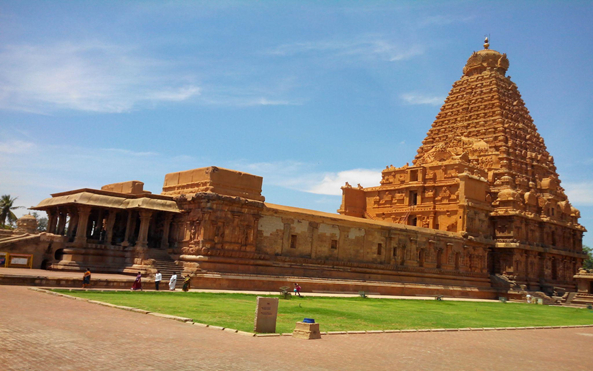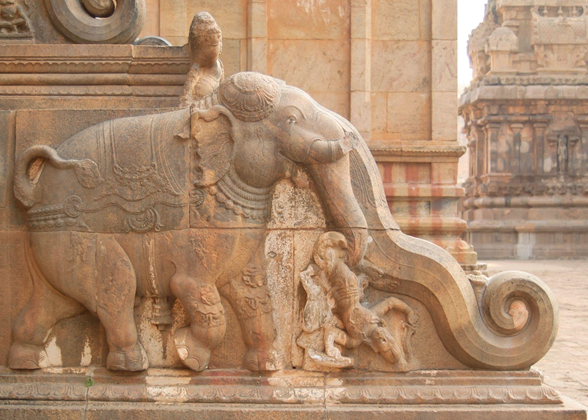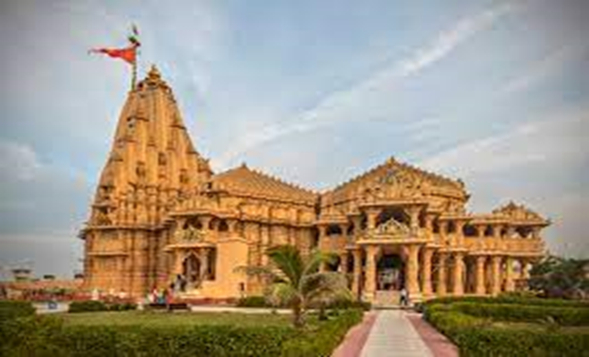

Towns were the core of any kingdom in medieval India. The emergence of big towns and cities started in the eighth century. It was the time of many big emirates like Cholas, Chalukyas and Pallavas. Each kingdom had many towns and they were classified according to their purpose. Some were Administrative towns, it was the residing place of kings and nobles and all the administrative activities were controlled from there. Other categories were a commercial town, Port town, Temple town etc. Towns were generally fortified and had a market in them. The rulers provided special protection to towns as they were one of the sources of revenue for the kingdom. Sometimes towns had more than one function. Thanjavur was an administrative centre for the Chola empire and it was also a pilgrimage town, as it had famous temples and shrines inside the town.

Somnath temple
B. SurajPatro1997, CC BY-SA 4.0
The Chola empire was founded by Vijayalaya in 850 CE. The Chola empire became one of the strongest kingdoms of that time. It gained control over all of southern India, Sri Lanka and the Maldives. Vijayalaya had captured Thanjavur from Pallavas. The greatest rulers of the Chola empire were Rajaraja Chola and Rajendra Chola.
Thanjavur became the capital of Cholas. Chola kings built many temples to celebrate their victories. Some of the most famous temples were the Brihadishwara temple and the Rajarajeshwar temple built by Rajaraja Chola. The Cholas had a tradition of installing the image and statues of kings and queens inside the temple campus.
The city of Thanjavur is situated on the banks of river Krishna and it became the biggest pilgrimage site. People would come here to worship and they were intoxicated by the marvellous architecture of the city.
Apart from the temple, the city had palaces with mandapas or platforms, from where the king held the courts and issued orders. There were barracks for the army stationed near the palace.
Another major feature of this town was the market. It was filled with traders selling food grains like wheat and millet. Spices, Jewellery and Clothes were the major items in the market.
Thanjavur played a crucial role in influencing the economy of nearby villages and towns. The Saliya weavers of Thanjavur and Uraiyur produced fine cotton clothes for the king and nobles and also for the public.
Weavers also produce clothes to make flags for ceremonies in the temple. Sculptures from the nearby village Svamimalai were experts in making Bronz idols and ornamental metal lamps. They produced multiple idols to sell in the market and also for the temples in the city.

Sculpture at Thanjavur
Matthew T Rader, https://matthewtrader.com, CC BY-SA 4.0
Temple towns were towns, which were built around a specific temple. Such types of towns were generally fortified and economic and social activities were related to temples. Thanjavur is an immaculate example of a temple town. It is built around the Brihadeshwar temple, which was built by Rajaraja Chola in the tenth century. The town of Thanjavur was the capital of the Chola empire.
Kings built temples to celebrate their victories and to demonstrate their devotion to the deities. The temples were given lands and grants. Temples were authorised to run their administration and collect the taxes from their land to feed the pilgrims and carry out rituals and celebrate festivals. Temples also received donations from the pilgrims and nobles.
Temples used their collected wealth to finance the banking system and trade. The vast income from temples was regulated by the temple committee. With the establishment of the temple, the community of priests, artisans, labourers, businessmen and others resided near the temple as they were dependent on the temple for their livelihood. They used to cater for the pilgrims who came to the temple. Gradually the number of communities living near the temple increased and a new town was formed.
There were many temple towns established in early medieval India, including Bhillasvamin in Madhya Pradesh and Somnath in Gujrat. Other significant temple towns were Kanchipuram and Madurai in Tamil Nadu and Tirupati in Andhra Pradesh. The pilgrimage sites gradually converted into townships. Tiruvannamalai in Tamil Nadu and Vrindavan in Uttar Pradesh is the example of such townships. The temple town of Ajmer showed the example of religious coexistence as it was the capital of Chauhan Kings in the 12th century and later the Sufi saint Khwaja Moinuddin Chisti settled there, which attracted many devotees and became one of the most famous shrines in India.

Somnath temple
B. SurajPatro1997, CC BY-SA 4.0
After the emergence of many new kingdoms and empires, many towns and cities were established. There were different kinds of towns in medieval India. Some were Administrative, Commercial, Port, temple towns, etc. Towns were classified on their characteristics. The temple town was formed when some people gradually started settling around the temple. Such communities were priests, labourers, artisans and all those who catered for the pilgrims and look for the administration of the temple. Thanjavur was the temple town in eighth-century India. It was established by the Chola empire and it became one of the most famous towns in India. Thanjavur also acted as a temple town as well as an Administrative town. The market of Thanjavur grew and people from nearby villages also profited from this trade. Temples received grants from kings and also had their land, from where they had the right to collect taxes.
Q.1. How urbanisation was influenced by temples?
Ans. Temples were the areas of continuous pilgrimages and to cater for the pilgrims some communities like priests, artisans, workers, etc. resided near the temples. There was the unification of the community and gradually this community grew and formed a town. Such towns were important in trade and commerce.
Q.2. Why Thanjavur was famous?
Ans. It was famous for its many characteristics −
Thanjavur had marvellous architecture.
It showed the high level of urbanisation.
It had a huge market selling Grains, Jewellery and clothes.
It was a pilgrimage site.
Q.3. Which communities benefited from the temple in Thanjavur?
Ans. Communities of weavers like Saliya of Thanjavur and Uriyar made cotton clothes for flags used in temple ceremonies and they also made clothes for kings and common masses. Another community was of Sculptors.
Q.4. How water was supplied to Thanjavur?
Ans. Water in the city came from the wells and tanks built by the kings. The water also came from the Krishna river.
Q.5. Which technique was used in the Chola period to make bronze statues?
Ans. In the Chola period, the Lost wax technique was used to make the Bronze statue. It was a technique which used wax and molten metal.